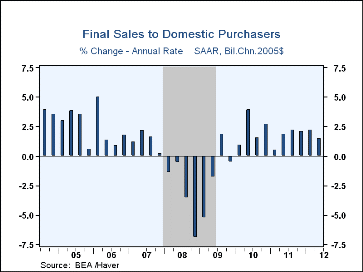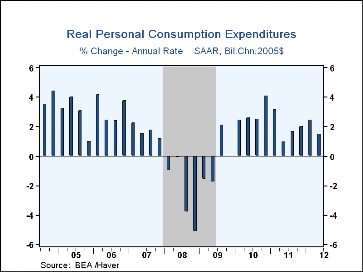 Global| Jul 27 2012
Global| Jul 27 2012U.S. GDP Growth Is Decelerating and Modest
by:Tom Moeller
|in:Economy in Brief
Summary
It remains a problematic growth environment. Real GDP advanced at an expected modest 1.5% annual rate during Q2'12 following 2.0% Q1'12 growth and a 4.1% Q4'11 advance. The gains continue to make this the weakest economic recovery on [...]
It remains a problematic growth environment. Real GDP advanced at an expected modest 1.5% annual rate during Q2'12 following 2.0% Q1'12 growth and a 4.1% Q4'11 advance. The gains continue to make this the weakest economic recovery on record. Data revisions extended back three years. Growth last year was little changed at 1.8%, but 2010 and 2009 were revised to 2.4% and -3.1% from 3.0% and -3.5%, respectively.
Inventory building added a modest 0.3 percentage points to GDP growth last quarter following small subtractions extending back through last year. Foreign trade deficit deterioration subtracted 0.3 percentage points from Q2 growth after a minimal addition in 2011. Exports grew at a 5.3% rate (4.3% y/y) while imports rose at a 6.0% rate (4.7% y/y) rate.
Domestic demand growth continued meager overall at 1.5% (2.0% y/y) although business fixed investment advanced at a firm 5.4% annual rate (10.2% y/y). Consumer spending grew at a modest 1.5% rate (1.9% y/y) led by services, up 1.9% (1.3% y/y), and nondurable goods, up 1.5% (1.1% y/y). Durable goods consumption spending fell at a 1.0% rate (+7.3% y/y), led by a 10.6% drop (+7.2% y/y) in motor vehicles consumption. Spending on apparel and home furnishings also fell q/q. Good weather and low interest rates helped residential investment advance at a 9.8% rate (10.7% y/y). Government spending continued to fall, last quarter at a 1.4% annual rate (-2.4% y/y). Federal spending was off 0.4% (-3.3% y/y) while state & local spending fell 2.1% (-1.8% y/y)
Price inflation as measured by the chain-weight price index rose at a moderated 1.6% (1.7% y/y) rate.
The latest GDP figures can be found in Haver's USECON and USNA databases; USNA contains basically all of the Bureau of Economic Analysis' detail on the national accounts, including the new integrated economics accounts and the recently added GDP data for U.S. Territories. The Consensus estimates can be found in AS1REPNA.
| .Chained 2005 $,% AR | Q2'12 (Advance) | Q1'12 | Q4'11 | Q2'12 Y/Y |
2011 | 2010 | 2009 |
|---|---|---|---|---|---|---|---|
| Gross Domestic Product | 1.5 | 2.0 | 4.1 | 2.2 | 1.8 | 2.4 | -3.1 |
| Inventory Effect | 0.3 | -0.4 | 2.6 | 0.3 | -0.2 | 1.5 | -0.8 |
| Final Sales | 1.2 | 2.4 | 1.5 | 1.9 | 2.0 | 0.9 | -2.3 |
| Foreign Trade Effect | -0.3 | 0.2 | -0.6 | -0.1 | 0.2 | -0.4 | 1.0 |
| Domestic Final Sales | 1.5 | 2.2 | 2.1 | 2.0 | 1.8 | 1.3 | -3.3 |
| Demand Components | |||||||
| Personal Consumption | 1.5 | 2.4 | 2.0 | 1.9 | 2.5 | 1.8 | -1.9 |
| Business Fixed Investment | 5.4 | 7.5 | 9.5 | 10.2 | 8.6 | 0.7 | -18.1 |
| Residential Investment | 9.8 | 20.6 | 12.0 | 10.7 | -1.4 | -3.1 | -22.4 |
| Government Spending | -1.4 | -3.0 | -2.2 | -2.4 | -3.1 | 0.6 | 3.7 |
| Chain-Type Price Index | |||||||
| GDP | 1.6 | 2.0 | 0.4 | 1.7 | 2.1 | 1.3 | 0.9 |
| Final Sales of Domestic Product | 1.6 | 2.0 | 0.4 | 1.7 | 2.1 | 1.3 | 0.9 |
| Final Sales to Domestic Purchasers | 0.7 | 2.5 | 0.9 | 1.6 | 2.5 | 1.6 | -0.2 |
Tom Moeller
AuthorMore in Author Profile »Prior to joining Haver Analytics in 2000, Mr. Moeller worked as the Economist at Chancellor Capital Management from 1985 to 1999. There, he developed comprehensive economic forecasts and interpreted economic data for equity and fixed income portfolio managers. Also at Chancellor, Mr. Moeller worked as an equity analyst and was responsible for researching and rating companies in the economically sensitive automobile and housing industries for investment in Chancellor’s equity portfolio. Prior to joining Chancellor, Mr. Moeller was an Economist at Citibank from 1979 to 1984. He also analyzed pricing behavior in the metals industry for the Council on Wage and Price Stability in Washington, D.C. In 1999, Mr. Moeller received the award for most accurate forecast from the Forecasters' Club of New York. From 1990 to 1992 he was President of the New York Association for Business Economists. Mr. Moeller earned an M.B.A. in Finance from Fordham University, where he graduated in 1987. He holds a Bachelor of Arts in Economics from George Washington University.










